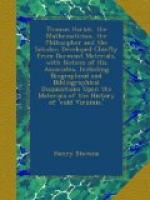However, till these lost jewels are found let us appreciate what is still left to us. Hariot’s ‘True Report’ is usually considered the first original authority in our language relating to that part of English North America now called the United States, and is indeed so full and trustworthy that almost everything of a primeval character that we know of ‘Ould Virginia’ may be traced back to it as to a first parent. It is an integral portion of English history, for England supplied the enterprise and the men. It is equally an integral portion of American history, for America supplied the scene and the material.
Without any preliminary flourish or subsequent reflections, the learned author simply and truthfully portrays in 1585-6 the land and the people of Virginia, the condition and commodities of the one, with the habits and character of the other, of that narrow strip of coast lying between Cape Fear and the Chesapeake, chiefly in the present State of North Carolina. This land, called by the natives Wingandacoa, was named in England in 1584 Virginia, in compliment to Queen Elizabeth. This name at first covered only a small district, but afterwards it possessed varying limits, extending at one time over North Virginia even to 45 degrees north.
Raleigh’s Virginia soon faded, but her portrait to the life is to be found in Hariot’s book, especially when taken with the pictures by Captain John White, so often referred to in the text. This precious little work is perhaps the most truthful, trustworthy, fresh, and important representation of primitive American human life, animals and vegetables for food, natural productions and commercial commodities that has come down to us. Though the ‘first colonie’ of Raleigh, like all his subsequent efforts in this direction, was a present failure, Hariot and White have left us some, if not ample, compensation in their picturesque account of the savage life and lavish nature of pre-Anglo-Virginia, the like of which we look for in vain elsewhere, either in Spanish, French, or English colonization.




